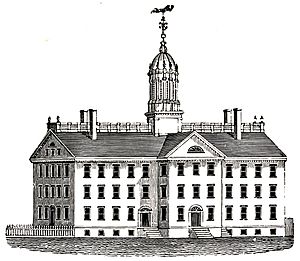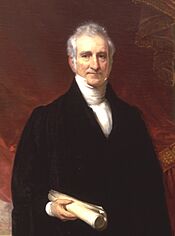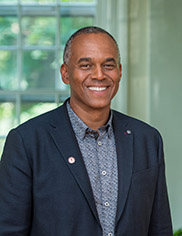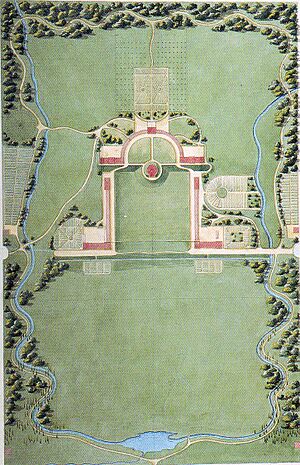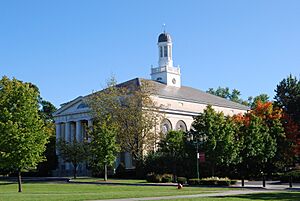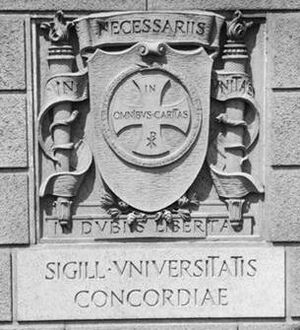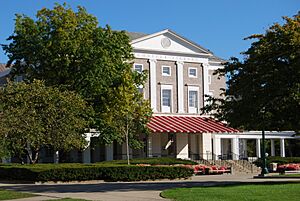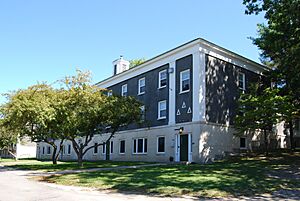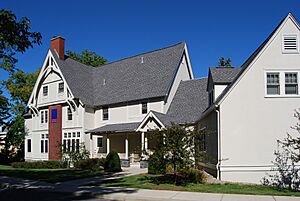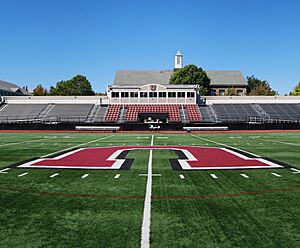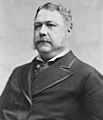Union College facts for kids
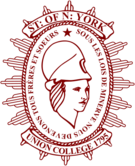 |
|
| Motto | Sous les lois de Minerve nous devenons tous frères et soeurs (French) |
|---|---|
|
Motto in English
|
Under the laws of Minerva, we all become brothers and sisters |
| Type | Private liberal arts college |
| Established | February 25, 1795 |
|
Academic affiliations
|
|
| Endowment | $498 million (2023) |
| President | Elizabeth Kiss |
|
Academic staff
|
207 FT/ 20 PT (2023) |
| Undergraduates | 2,082 (2023) |
| Location |
,
U.S.
42°49′02″N 73°55′48″W / 42.81722°N 73.93000°W |
| Campus | Urban: 120 acres (49 ha), including 8 acres (3.2 ha) of formal gardens |
| Colors | Union garnet Black Gray |
| Nickname | Garnet Chargers |
|
Sporting affiliations
|
NCAA Div I – ECAC Hockey Div III – Liberty League |
 |
|
Union College is a private college located in Schenectady, New York. It was founded in 1795. It was the first college in New York State to be officially approved by the New York State Board of Regents. Only Columbia University was older in New York.
In the 1800s, Union College became known as the "Mother of Fraternities". This is because three of the very first student clubs, called fraternities, started there. Union College began accepting women students in 1970. Before that, it was an all-male school for 175 years. The college offers many different subjects, including engineering programs.
Contents
History of Union College
How Union College Started
Union College received its official charter in 1795. It was the first college in the United States that was not tied to a specific religion. It was also the second college to be established in New York State.
Only Columbia University, founded in 1754, was older in New York. People in Schenectady wanted another college. Schenectady was a large city, with about 4,000 people.
A local church became interested in starting a school there. In 1785, the Schenectady Academy was created. It quickly became popular, with about 100 students in its first year. By 1792, it offered a full four-year college program. It also taught basic subjects, mainly to girls.
At first, the state did not approve the academy as a college. But in 1794, the school tried again. They chose the name "Union College." This name showed that the founders wanted the school to be open to everyone, without any religious ties. The college officially received its charter on February 25, 1795. This day is still celebrated as "Founders' Day."
The 1800s at Union College
In 1836, students at Union College formed an Anti-Slavery Society. It had 51 members. They wrote a message asking all students to join the movement to end slavery. Many speeches given at the college before the Civil War supported ending slavery or other progressive ideas.
During this time, Union College was sometimes called Schenectady College.
College Symbols and Nickname
Union College chose a French motto instead of a Latin one. This showed a modern way of thinking. The college's seal features the head of Minerva, a Roman goddess. She represents wisdom and learning.
The original motto in French meant "Under the laws of Minerva, we all become brothers." In 2015, "and sisters" was added to the motto.
Minerva was seen as a symbol of wisdom and science. She represented qualities like being smart, good, and thoughtful.
In 2023, the college changed its sports nickname. It used to be "Dutchmen" and "Dutchwomen." Now, it is the "Garnet Chargers." Garnet has been the school's color for 150 years. "Chargers" refers to Schenectady's history in electrical technology.
Union College Presidents
Union College has had nineteen presidents since it started in 1795. One of its presidents, Eliphalet Nott, served for 62 years. This is the longest time anyone has been a college president in U.S. history.
David R. Harris was the president from 2018 until June 30, 2025. On February 25, 2025, Union College announced that Elizabeth Kiss would become its first woman president. She started her role on July 1, 2025.
What Students Study
In the early 1800s, students at American colleges studied similar subjects. These were mostly traditional liberal arts. But by the 1820s, things began to change.
New subjects were added that were more useful for business. French was slowly added to the college's courses. It sometimes replaced Greek or Hebrew.
Union College started a "parallel course of study" in 1828. This meant students could choose between a traditional course or a more modern science-focused one. Both were considered equally important.
In 1845, Union College started a civil engineering program. This was the first of its kind at a liberal arts college in America. Union's new programs were very successful. By 1839, Union College had one of the largest teaching staffs. It also had more students than almost any other college, except Yale University.
Union College Campus
Campus Design
After Union College received its charter in 1795, classes began. But the space was too small for the growing college. A new three-story building was built and used in 1804. Two dormitories were also built nearby.
When Eliphalet Nott became president in 1804, he wanted the campus to grow. In 1806, the college bought a large piece of land. In 1812, a French architect named Joseph-Jacques Ramée was hired. He created a full plan for the new campus. Two college buildings were built quickly and used by 1814. Union College became the first college in the United States with a fully planned campus.
Campus Landmarks
Nott Memorial: This unique building was designed by Edward Tuckerman Potter. It was likely meant to be a chapel at first. But its main purpose became its beautiful design. It was the library until 1961. The building was added to the National Register of Historic Places in 1972. It was named a National Historic Landmark in 1986. The Nott Memorial was restored between 1993 and 1995. Today, it is the most important building on campus.
North and South College: These were the first college buildings built using Ramée's plans. They were started in 1812 and used in 1814. They served as dormitories for students. Teachers also lived in these buildings for many years.
Memorial Chapel: This chapel was built between 1924 and 1925. It serves as the main college chapel. It also honors Union graduates who died serving in wars. The names of alumni who died in World War I and World War II are on its south wall.
Schaffer Library: Schaffer Library opened in 1961. It was the first building at Union built only to hold the college library. A trustee named Henry Schaffer gave most of the money for its construction. He also helped fund an expansion in the 1970s. The library was renovated and expanded again in the late 1990s. This renovation added space for media services, a writing center, and a language lab.
Jackson's Garden: Professor Isaac Jackson started this garden in the 1830s. Jackson's Garden is 8 acres of formal gardens and woodlands. It was originally planned to be a garden by Ramée. It had a mix of vegetables, shrubs, and flowers. Some seeds came from botanists around the world. By 1844, famous visitors like John James Audubon admired it. It became a peaceful place for students and teachers.
How Union College is Run
Board of Trustees
The "Trustees of Union College" is a group that owns the college. They are the college's official legal representatives. The Board includes alumni, teachers, students, and the college president. The governor of New York State is also a member. The Board chooses the college president when the position is open.
The Student Forum
The Student Forum is the main student government at Union College. Its goal is to create rules for students. The student body is represented by a president and several vice-presidents. These include leaders for administration, finance, academics, campus life, and multicultural affairs. The Student Forum also includes two student trustees and 12 class representatives.
College Groups and Connections
Union College belongs to several groups. These include the Liberty League, ECAC Hockey, the Annapolis Group, and the Oberlin Group. It is also part of the Consortium of Liberal Arts Colleges (CLAC) and the New York Six Consortium. Union College is also a part of Union University. This larger group includes Albany Medical College, Albany Law School, and other schools.
Student Media
Union College has a radio station, WRUC 89.7. It started as a student project in 1910 and began broadcasting in 1912. It was one of the first radio stations in the country to have regular programs. The weekly newspaper, Concordiensis, has been published since 1877. It is one of the oldest student newspapers in the United States. It is also the oldest continuously published newspaper in Schenectady.
Academics at Union College

Most students need to complete at least 36 courses. Engineering students might need up to 40 courses. Students in the Leadership in Medicine program need about 45–50 courses.
In 2022, the most popular subjects for graduates were:
- Economics
- Biological and Biomedical Sciences
- Mechanical Engineering
- Political Science and Government
- Research and Experimental Psychology
- Neuroscience
Admissions to Union College
| USNWR Liberal Arts College | 40 |
|---|---|
| Washington Monthly Liberal Arts | 86 |
| Forbes | 148 |
For the Class of 2029, Union College received 9,243 applications. It accepted 3,529 students, which is about 38.2%. The middle range of SAT scores for accepted students was 1370–1490 for math and reading. The middle range of ACT scores was 31–34.
Student Research
Students at Union College have been involved in research since the early 1900s. A chemistry professor, Charles Hurd, started including students in his studies. Now, student research is a key part of the Union education in all subjects.
By the mid-1960s, many subjects required a senior research project. In 1978, the college began funding student research with teachers. In 1986, they started offering funded summer research opportunities for students.
Study Abroad Programs
Union College offers many chances to study outside the United States. The most popular are the Terms Abroad Programs. These programs allow students to live and study in many different countries. In the 2009–2010 school year, programs were offered in 22 countries.
Every year, Union College also has "mini-terms." These are three-week programs during winter break or at the start of summer vacation.
Schaffer Library
Schaffer Library opened in 1961. It has about 750,000 books in print and digital formats. The library's collections are very strong in literature from the 1700s and 1800s. They also have many books about the Scientific Revolution and the Enlightenment. The college's first library, from 1795 to 1799, is almost completely preserved here.
Union College is part of several groups that help students access books and materials not owned by the college.
Student Life
Fraternity and Sorority Life
The modern system of fraternities at American colleges started at Union College. The first ones were Kappa Alpha Society (1825), Sigma Phi (1827), and Delta Phi (1827). Three other national fraternities – Psi Upsilon (1833), Chi Psi (1841), and Theta Delta Chi (1847) – also started at Union. Because of this, Union is called "The Mother of Fraternities."
In fall 2021, 33% of female students were in a sorority. 24% of male students were in a fraternity. In 2010, about half of Union's older students were members of its twelve Greek-letter groups.
Union has six fraternities: Alpha Delta Phi, Chi Psi, Kappa Alpha Society, Sigma Chi, Sigma Phi, and Theta Delta Chi. There is also a co-ed community service fraternity, Alpha Phi Omega.
There are three sororities at Union: Delta Phi Epsilon, Gamma Phi Beta, and Sigma Delta Tau. There are also multicultural Greek groups like Alpha Phi Alpha, Phi Iota Alpha, Iota Phi Theta, Lambda Pi Chi, and Omega Phi Beta.
Minerva System
In 2004, Union College changed its rules for fraternities and sororities. The college took back some control of the houses. This was done to improve student social life.
A new "house system" was created. These houses, called Minerva Houses, are places for students to gather. They are centers for learning, social events, and culture. All new students are randomly assigned to one of the seven Minerva Houses. An office was created to manage these activities.
Arts and Culture
Art Galleries
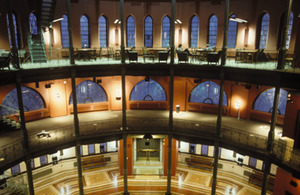
The Mandeville Gallery has an annual Art Installation Series. Artists visit the campus and create special art pieces for the library.
The Wikoff Student Gallery shows art made by current Union College students. The college owns over 3,000 pieces of art and artifacts. These are used by teachers and students for learning and research.
Performances and Shows
The Music Department hosts talks, performances, and workshops by visiting artists. These happen at places like the Taylor Music Center and Memorial Chapel. Union College has jazz, choral, and orchestral groups. There is also a taiko drum group and student a cappella groups. They perform regularly.
The Theater and Dance Department puts on several big plays each year. They also have student performances and guest shows.
Athletics at Union College
Union College offers 26 sports for competition.
- Men's Sports: Baseball, basketball, crew, cross-country, football, ice hockey, lacrosse, soccer, swimming, tennis, and indoor and outdoor track.
- Women's Sports: Basketball, crew, cross-country, field hockey, golf, ice hockey, lacrosse, soccer, softball, swimming, tennis, indoor and outdoor track, and volleyball.
Union College is part of the National Collegiate Athletic Association (NCAA). Men's and women's ice hockey teams play in NCAA Division I. All other sports play in NCAA Division III. Union also competes in the Liberty League, ECAC Hockey, and the Eastern College Athletic Conference (ECAC).
Many club sports are also available. Popular clubs include baseball, bowling, fencing, golf, ice hockey, karate, rugby, skiing, volleyball, and ultimate frisbee. The college also has many intramural sports and physical education classes.
Sports facilities include the Frank L. Messa Rink, the David Breazzano Fitness Center, and Frank Bailey Field.
Union has hosted the two longest games in NCAA Men's Hockey History. Both games ended with Union losing 3–2 in overtime. The longest game was on March 12, 2010. Quinnipiac University won after 90 minutes of overtime. The second-longest game was on March 5, 2006. Yale University won after 81 minutes of overtime.
The Union football team had a perfect regular season in 1989, winning all 10 games. They lost to Dayton in the NCAA Division III Football Championship game, 17–7.
Famous People from Union College
- Chester A. Arthur (1848), the 21st president of the United States.
- William H. Seward (1820), who was Secretary of State under Abraham Lincoln. He helped arrange the Alaska Purchase.
- George Westinghouse, a famous engineer, inventor, and businessman.
- Martin Jay (1965), a well-known historian and professor.
- Andrea Barrett (1974), a writer who won the National Book Award and the Pulitzer Prize.
- Baruch Samuel Blumberg (1946), who won the Nobel Prize in Physiology or Medicine.
- Jimmy Carter, the 39th president of the United States, studied nuclear physics at the Graduate School.
- Alan F. Horn (1964), a top executive at Walt Disney Studios and former president of Warner Bros..
- Fitz Hugh Ludlow (1856), author of The ... Eater.
- Howard Simons (1951), managing editor of The Washington Post during the Watergate time.
- Rich Templeton (1980), an engineer and former CEO of Texas Instruments.
- Nikki Stone (1995), who won a gold medal in the 1998 Winter Olympics for aerial skiing.
- Jake Fishman (2018), an American-Israeli baseball pitcher for the Miami Marlins. He played for Team Israel in the 2020 Olympics. He is the only Union player drafted in the MLB draft.
Images for kids
-
Chester A. Arthur (1848), the 21st president of the United States
-
William H. Seward (1820), Secretary of State under Lincoln
-
Gordon Gould (1941), physicist credited with the invention of the laser
-
Nobel Laureate Baruch Samuel Blumberg (1946)
-
Neil Abercrombie (1959), seventh governor of Hawaii
See also
- Union College Men's Glee Club
- List of colleges and universities in New York
- National Register of Historic Places listings in Schenectady County, New York
- List of Union College alumni



